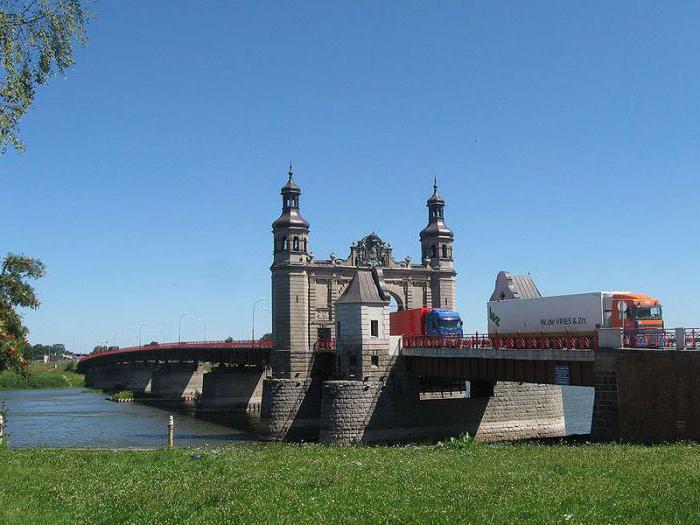The city of Sovetsk in the Kaliningrad region, which until 1946 was called Tilsit, is currently going through hard times. This is due to the closure of many enterprises, educational institutions and even some departments in the hospital.
However, there are places of interest in this city that, after joining the Russian Federation, were renamed Sovetsk (Kaliningrad Region).
The city was founded at the confluence of two rivers - Tylzhi and Neman. Nowadays, it is connected by a car-foot bridge with the Lithuanian town of Panyamune. It is noteworthy that the latter is the smallest city in its country, and Sovetsk is the second largest in the region after Kaliningrad.
Queen's Bridge
On the bridge linking two different countries, there is customs. By the way, this building is one of the attractions of the city. It is called Queen Louise Bridge (Sovetsk). Princess Mecklenburg-Strelitzkaya was the wife of King of Prussia Friedrich Wilhelm III.

Her family tree is closely connected with the Romanovs' house, since Louise is the grandmother of the Russian Emperor Alexander II. She was an object of adoration in her circle, her manners were not stiff, the lady was nice in communication, which increased the number of fans of the beautiful Louise. Her name is associated with the rise of Prussia and the formation of Germany. The king and queen of Prussia gained popular respect, sharing with the people various holidays, easily communicating with subjects in the streets of the capital. When the troops of Napoleon began to seize the countries of Europe, the king and queen of Prussia were forced to flee. It was in Tilsit that Queen Louise met with the French emperor. Although the concluded Tilsit Peace Treaty was very burdensome for Prussia, Napoleon spoke very highly of the beauty and mind of Queen Louise.
Bridge description
By its architecture, the Queen Louise Bridge (Sovetsk) is an arch. Its construction began in 1904, and ended three years later. Its discovery was timed to coincide with the centenary of the conclusion of the Tilsit peace.
The bridge on the sides has two beautiful turrets, and the south portal was decorated with a bas-relief depicting Queen Louise. At the top of the arch stood six beautiful vases. Unfortunately, only two survived to our times. In Tilsit, a monument was also erected to the Queen of Prussia, which was restored in Sovetsk.
Castle
The city has an old Tilsit castle , which was founded at the very beginning of the XV century. In 1404, the master of the Teutonic Order Konrad von Jungingen ordered the construction of a fortress here to protect the Teutonic lands from the incursions of the Litvinians. Literally a year after the final completion of construction, the castle was attacked and destroyed. But it was quickly restored. Over the following centuries, the castle was constantly being built and strengthened.

Especially powerful bastions of the fortress were erected in the middle of the XVII century. But a century later, the castle gradually lost its strategic importance and was bought out by Tilsit merchants. First, a casino was located in the fortress, then the Irena Masonic lodge and, finally, the city court. A few decades later, a timber warehouse was arranged in the castle, then the construction became a place for steam oil mills and mills. In the middle of the XIX century, a machine-building factory was equipped here, and after thirty years - a paper factory. In 1876, a fire broke out in the castle, which severely damaged the building. The ruins of a once formidable citadel were converted into a plant for the manufacture and calcination of lime, and at the end of the last century the castle was finally abandoned. About six years ago, the city hall decided to assign the status of a cultural heritage object to the castle ruins. Subject to restoration work, the former fortress may well contribute to an increase in the number of tourists.
City of Sovetsk. Tram Monument
This monument is installed on the central square of the city. From 1901 to 1944, the tram was an urban mode of transport. There were four routes. But with the transfer of Tilsit to the Soviet Union, the city leadership decided that road transport was much more efficient, and replaced trams with buses. In 2012, a tram car was brought from St. Petersburg. After which it was installed directly on the rails. So there was a monument tram (Sovetsk). Inside this unusual car, exhibitions of photographs are organized. Near the tram is a lamppost. Signs with street names in Russian and German are attached to it.
What is worth seeing for those who are studying Sovetsk (Kaliningrad Oblast)? Attractions, of course. In Sovetsk, the houses and streets themselves are already them. Ancient buildings under red tiles, streets paved with cobblestones carry the traveler, if not to the Middle Ages, then one or two hundred years ago.
Theater
What should tourists who are interested in Sovetsk (Kaliningrad Oblast) see? Sights. They are few in the city, but they are. Now let's talk about one of them.
Seven years before the end of the 19th century, a theater was built in the city. It was named after the city - "Tilsit Theater". The first production was Goethe's play Egmont. At the end of the last century, the theater of a young spectator was opened in the building. But residents still call it the Tilsit Theater.
Conclusion
Now you know what Sovetsk (Kaliningrad Oblast) represents, we examined the sights of this city. We hope that the information presented in the article will be useful to you.